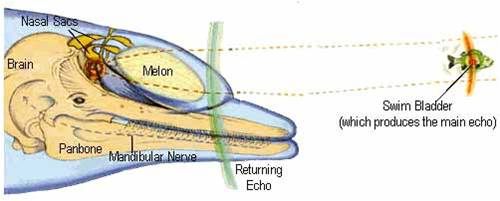A research project on the development of echolocation was recently conducted in Monkey Mia as a collaboration between Lars Bejder of Murdoch University, Lara Delgado and Magnus Wahlberg of the University of Southern Denmark, and Ann-Louise Jensen of the Fjord&Baelt Research Center.
Odontoceti, or toothed whales, among which are bottlenose dolphins, have developed very complex acoustic systems for communicating and scanning their environment. The different kinds of sounds they make have specific purposes, for instance clicks for echolocation and whistles for communication. Echolocation, also known as biosonar, is a natural radar that toothed whales have developed. They emit short sounds, called clicks, that bounce off the objects in their surrounding environment. The dolphins can then listen to the returning echoes, and then “see” what’s around them based on the sounds!

Furthermore, dolphins living in captivity may behave differently acoustically than wild dolphins, so results from captive animals may not be representative of what happens in the wild. Data had never before been collected on the echolocation abilities of free-ranging newborn dolphins.
The Monkey Mia dolphins offer a rare and exciting possibility to study the development of echolocation in infants, as well known dolphins come in on a regular basis to the beach, and are habituated to human presence, enough so that they will even bring their newborns close to shore a few days or even hours after birth.


When the clicks bounce off fish and other objects in the water, based on their echoes, the dolphin can determine how far away the fish is and in what direction. They can probably also tell different types of fish apart, and whether there is a single fish or a whole school of them. Dolphins are superb echolocators. Whereas objects can be seen at distances up to a few tens of meters in water, it has been shown that dolphins can detect objects by echolocation at ranges way beyond 100 meters.
Little is known about how this very specialized sense develops in dolphins. When can a newborn echolate? Is it similar to adult echolocation or does it change with development? Even though many dolphins have been born in aquaria around the world, very few researchers have had the opportunity to record the young calves with the appropriate type of gear, and they often miss the first few days after birth that may be the critical period in which this behavior develops.

So researcher Lara Delgado was able to conduct field work in Monkey Mia beginning when regular beach visitor, Surprise, gave birth to the aptly named “Sonic” on November 18th, 2010. Their regular visits enabled Lara to get daily recordings for the next six weeks. She joined the rangers in the feeding sessions at the beach to obtain recordings of both adult animals and the newborn Sonic. The recordings of different individuals were important for comparison.
The recordings were made by submerging hydrophones (underwater microphones) into the water. Three hydrophones were aligned in order to triangulate where the sound came from and synched with video recordings to observe which animal was echolocating and how far away they were. By recording the signals made by the calf we hope to understand how the echolocation signals develop with age, and how the calf uses them to investigate objects in the water.

The study is part of a Danish research program on echolocation in toothed whales and bats, funded by the Danish National Research Council.